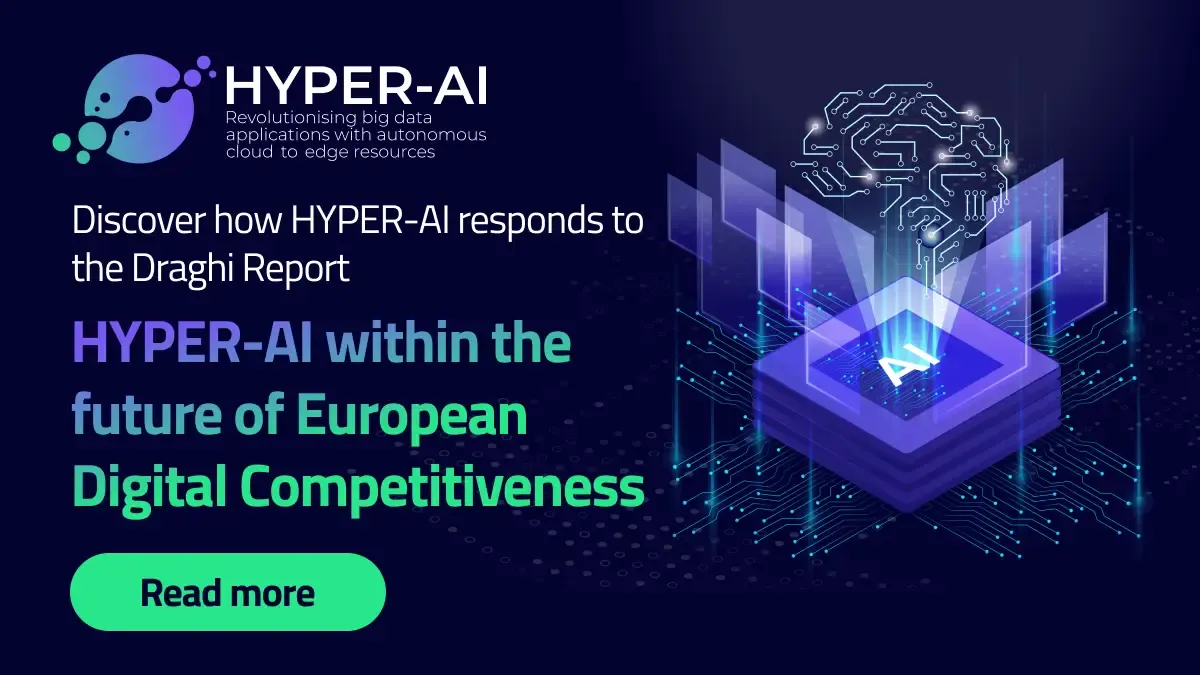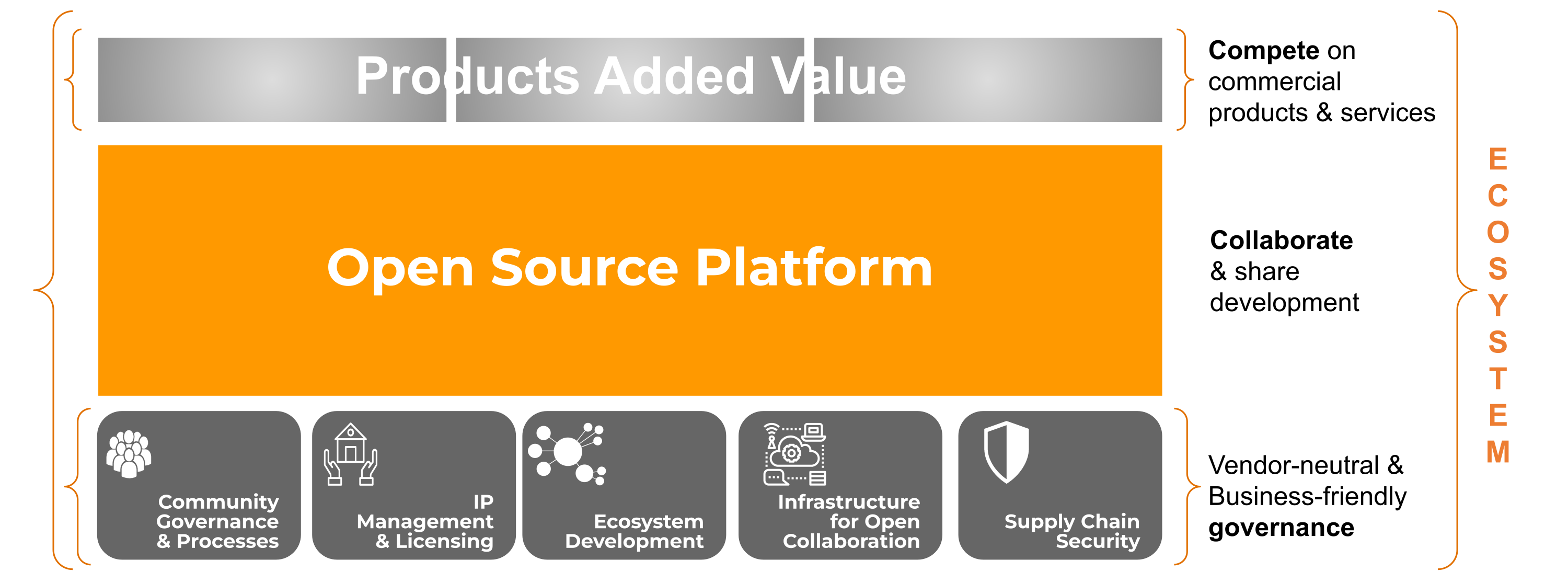HYPER-AI within the future of European Digital Competitiveness
26, September, 2024
·5 minutes read
·

Earlier this month, Mario Draghi, former Italian Prime Minister in 2021-22 and President of the European Central Bank in 2011-19, delivered a report to address European competitiveness by proposing a new industrial strategy for Europe. Produced at the request of the European Commission, this report outlines urgent recommendations to reinvigorate Europe’s economy, by closing its innovation gap, creating a joint plan for decarbonisation and competitiveness, increasing its security, and reducing foreign dependencies.
Among the ambitious recommendations for the EU’s economy, many of Draghi’s analyses are also pertinent for the Horizon Europe-funded project HYPER-AI, particularly concerning the future of Europe’s digital transformation and the role that distributed computing can play in the EU’s competitiveness. Given the status of AI as “an evolving technology in which EU companies still have an opportunity to carve out a leading position in selected segments”, HYPER-AI’s research outcomes could have significant economic outcomes through strengthening the EU’s competitive advantage in AI technologies.
In this article, we consider the key findings of the Draghi report that are relevant to the HYPER-AI project goals, to discover how HYPER-AI will contribute towards Europe’s digital competitiveness, and ensure a Digital Europe that is equipped with the technology to implement hyper-distributed AI platforms for network resources automation and management.
The role of HYPER-AI in Europe’s productivity challenge
Draghi examines AI, Cloud, digital innovation in Chapter 2, “Closing the innovation gap”, raising both potential opportunities and challenges for HYPER-AI.
Firstly, the challenge of Europe’s productivity is considered. In light of predicted GDP stagnation by 2040, due to a shrinking future European workforce, Draghi identifies that “the key driver of the rising productivity gap between the EU and the US has been digital technology”.
Acknowledging the EU’s competitive disadvantage in cloud computing, Draghi stresses the importance of maintaining digital sovereignty, particularly in security and encryption, while developing technologies to support innovation in adjacent fields. However, this is not the only opportunity: Europe also has the chance to “capitalise on future waves of digital innovation”.
Inherent security
HYPER-AI will respond to the priority of digital sovereignty by advancing decentralised models of data, trust, and security.
To ensure that distributed AI, IoT, and robotics systems are secure, HYPER-AI will provide a zero-trust paradigm for these systems, ensuring that authentication is built into every stage of operation. This paradigm will implement distributed end-to-end cybersecurity and data privacy mechanisms, to allow privacy-preserving management of user identities, secure data accesses, sovereignty, and privacy protection.
Ongoing cybersecurity research, collaborations with other related EU research efforts, and open-source software will also inform the development of this decentralised framework.
Strategic use cases
Furthermore, Draghi identifies that AI can be integrated ‘vertically’ into European industry as “a critical factor in unlocking higher productivity”, a directive which directly aligns with HYPER-AI’s planned integration of its architecture into 5 vertical use cases. Mirroring the recommendation in the report, the work on these use cases has the goal of demonstrating the advances that can be made as a result of mobilising new AI technologies to support innovation in other fields.
Through testing features of the HYPER-AI architecture, across scenarios in Manufacturing, Green Energy, Mobility and Automotive, Farming and Agriculture, and Healthcare, the project will aim to demonstrate improved efficiency and innovation, thanks to improved access to big data processing with AI-enabled management of operations and resources.
Not only will these 5 use cases validate the research outcomes of the project, but their development and execution will also provide a valuable opportunity for the commercialisation of research through collaboration between academic and industrial partners.
Strength in collaboration
Academic and private sector collaboration is another current EU weakness which Draghi highlights, despite its strong position in fundamental research and patenting, that the HYPER-AI project can respond to. Indeed, this could accelerate the integration of AI into European industry, which could benefit strategic sectors for the EU, 5 of which are directly targeted by the HYPER-AI use cases.
Additionally, Draghi recognises the support that open-source frameworks could provide for AI innovation, proposing “AI Sandboxes” for collaborative experimentation within a wider “AI Vertical Priorities Plan”. Aligning with the goals of this plan, HYPER-AI similarly considers integrating open-source technologies and practices at as many stages of the project as possible, to reap their benefits and implement best practices established by open source.

HYPER-AI’s agility against innovation barriers
Yet, one challenge that could persist despite the innovations of HYPER-AI would be “competition for computing power and lack of investment in connectivity”, which “could soon translate into digital bottlenecks”. Given the global shortages of chips, driven in part by rapidly rising costs of training AI models and using computational power, smaller and less-well funded EU companies utilising AI and compute could struggle to compete against competitors in the US and China.
One of the fundamental goals of HYPER-AI is to improve the efficiency of data-processing applications, through innovating autonomous networks of smart “nodes” (virtual computing entities across all of Cloud, Edge, and IoT) to provide access to computational, storage, and network services. However, this breakthrough of the project – to integrate all resources across the computing continuum into a hyper-distributed and AI-enabled network – foresees improvements to the current fragmentation of EU networks, which makes it harder to capitalise new technologies and make the necessary investments to achieve the goal of 10,000 climate-neutral, secure edge nodes deployed in the EU by 2030.
Nevertheless, the project will examine this and other risks to develop mitigation strategies, and will ultimately deliver valuable technology that can be readily exploited following investments in EU networks.
Join the Conversation: Register for Our Webinar
To explore how HYPER-AI is addressing pressing concerns for Europe’s technological development, we invite you to join our Cognitive Computing Continuum webinar on 8th October 2024. This webinar will bring together members of the HYPER-AI project, alongside related projects in the Cognitive Continuum Computing cluster, to give an exposition of research that is developing strategic technologies for Europe.
This is your opportunity to learn more about how HYPER-AI’s outcomes could shape the future of European AI and distributed computing, and to ask your questions directly to the project leaders.
Register now to secure your place and stay informed on Europe’s digital transformation.